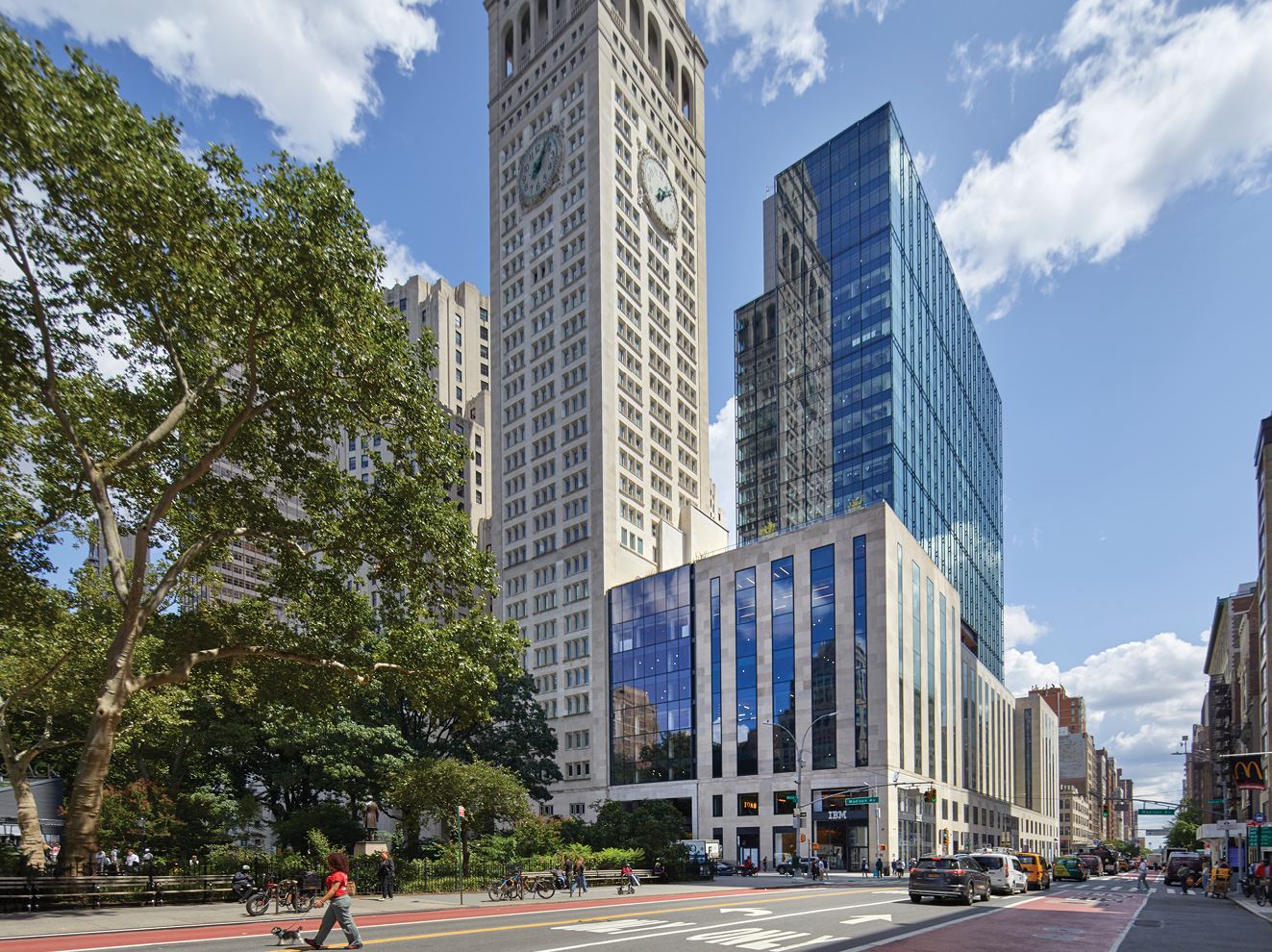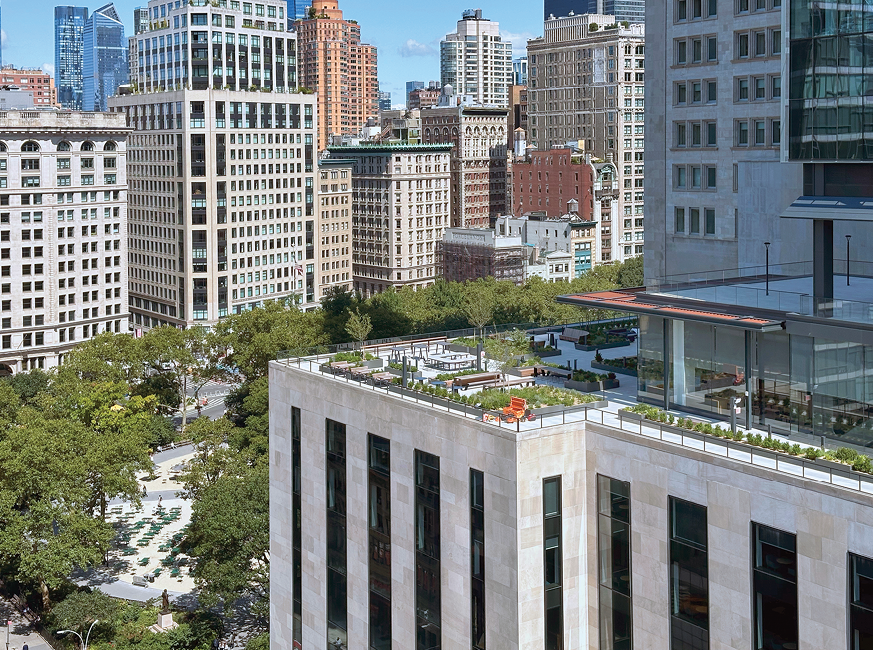- Home
- Media Kit
- MediaJet
- Current Issue
- Past Issues
- Ad Specs-Submission
- Reprints (PDF)
- Photo Specifications (PDF)
- Contact Us
- PRIVACY POLICY
- TERMS OF USE
![]()
ONLINE
![]()
ONLINE

Redefining The Modern Workplace
Editors’ Note
Harrison Sitomer serves as SL Green’s Chief Investment Officer, overseeing the company’s investment platform. He is responsible for sourcing and executing the company’s acquisitions, dispositions, financings, and joint ventures, along with debt and preferred equity investments. Sitomer serves on the Board of Directors of the American Friends of the Rabin Medical Center and is a member of the Milken Institute Young Leaders Circle and a past member of the David Rockefeller Fellowship Program. He received a BA degree from the University of Pennsylvania and joined SL Green in 2012.
Company Brief
SL Green Realty Corp. (slgreen.com), Manhattan’s largest office landlord, is a fully integrated real estate investment trust, or REIT, that is focused primarily on acquiring, managing and maximizing the value of Manhattan commercial properties. As of June 30, 2025, SL Green held interests in 53 buildings totaling 30.7 million square feet. This included ownership interests in 27.2 million square feet of Manhattan buildings and 2.7 million square feet securing debt and preferred equity investments.
How do you describe SL Green’s mission and purpose?
SL Green’s mission is to maximize long-term shareholder and investor value by actively acquiring, financing, managing, and repositioning Manhattan commercial properties, primarily in the office and retail sectors. The company manages capital on behalf of public shareholders, third party joint venture partners, fund investors and CMBS bondholders. As a company deeply rooted in New York City, our future and purpose are inseparable from the city’s success, and we’re committed to contributing to its growth and resilience in everything we do.
Our business continues to evolve in step with the needs of the city, supporting the businesses and institutions that keep New York running. We lead in sustainability, foster tenant and community well-being, and drive strong financial performance through a focused, transaction-driven strategy.
Internally, we maintain a culture centered on excellence, collaboration, and community engagement. Our team is the best of the best in the industry, and we remain committed to supporting their growth through ongoing education, self-development, and continuous innovation.
“As a company deeply rooted in New York City, our future and purpose are inseparable from the city’s success, and we’re committed to contributing to its growth and resilience in everything we do.”
What are your views on the current state of the New York City commercial real estate market?
We’re in a healthy market right now. New York remains in a league of its own when it comes to capital and development interest. From a global perspective, the city continues to offer unmatched liquidity, deep tenant demand, institutional sponsorship, tenant diversification and long-term value preservation. High-quality assets are outperforming, and there’s growing momentum around converting underused office buildings to residential or mixed-use which will further accelerate the success of the city. There’s also a significant scarcity of well-located office development sites that can be delivered over the next four to five years. That supply constraint, paired with record growth in employment, Wall Street profits, and bank earnings, gives us strong confidence in the long-term strength of a market we’ve thrived in for nearly 30 years.
At the same time, we see significant opportunity from the dislocation between rapidly improving leasing fundamentals and continued macroeconomic debt capital market dislocation. In July, we announced that our opportunistic debt fund had raised more than $1 billion to target high quality assets in New York City, where traditional financing remains constrained.
“New York City isn’t just our home; it’s our business, and it is challenging for us to succeed if the communities around our buildings aren’t thriving. So, we approach every asset through the lens of improving the community and the broader city.”
What have been the keys to SL Green’s industry leadership, and how do you define the SL Green difference?
The SL Green difference lies in the combination of deep local knowledge and institutional continuity. Manhattan is our backyard, and we’ve built our business around knowing this market better than anyone else. Unlike other REITs with a passive buy-and-hold approach, we actively buy, sell, and reposition assets to maximize returns and adapt to shifting market dynamics.
We are Manhattan office sharp shooters, trading on our deep expertise and a long track record of success. We’ve developed some of the city’s most iconic properties, including One Vanderbilt Avenue and One Madison Avenue – setting new benchmarks in design and sustainability, and unlocking hidden value through strategic redevelopment. Our commitment to a best-in-class tenant experience has played a key role in encouraging return-to-office and positioning SL Green at the forefront of New York City’s post-pandemic revival.
But the SL Green difference, the variable that makes that work possible, is our extraordinary executive leadership team. I’ve had the privilege of working alongside an exceptional group of leaders, led by our CEO, Marc Holliday, most of whom have been with the company for two decades or more. The access to industry experts who lead their respective disciplines within the firm – leasing, legal, tax, finance, operations – is a rare privilege for me. For example, Edward Piccinich, the Company’s Chief Operating Officer, has been with the company for over two decades and oversees hundreds of employees across nearly a dozen verticals. Ed is the most methodical, disciplined, and organized person I have worked with, and I have benefited enormously from him and his department’s direct knowledge and experience operating and developing real estate. On the construction cost side, I am able to work directly with Robert Dewitt – Ed’s SVP of Construction who has been responsible for overseeing the development of One Vanderbilt Avenue and One Madison Avenue, as well as our portfolio interior construction and robust development pipeline. I also work directly with Meghann Gill – Ed’s SVP of Operations who oversees the operations of the entire SL Green portfolio from budgeting and capital planning, code compliance, contract management, and operational procedures. It is this direct and precise input from foremost experts who are aligned with our investment objectives that is unmatched in the industry.

One Madison Avenue (above and below)
Will you discuss SL Green’s focus on providing leading hospitality offerings to enhance the tenant experience?
Our goal is to transform the traditional office experience into more people-centric workspaces of the future. Our tenants are offered a dedicated hospitality team that manages concierge services and building-wide amenity programs, such as gourmet cafés and Michelin-starred restaurants, state-of-the-art fitness centers, meeting and event spaces, outdoor green spaces, and more. One Madison Avenue, for instance, has become the hallmark example of hospitality-driven development. Le Jardin sur Madison, designed by renowned architect David Rockwell, is utilized daily by tenants and their guests as a serene place to work or connect, and in the evening is transformed into a one-of-a-kind event venue that immediately impresses.
These elevated experiences strengthen tenant loyalty and drive strong leasing momentum. As we continue investing in both our buildings and the environments within them, we see meaningful returns across the portfolio while redefining the modern workplace.
How is SL Green committed to not just developing buildings, but also to transforming communities, as part of its projects?
New York City isn’t just our home; it’s our business, and it is challenging for us to succeed if the communities around our buildings aren’t thriving. So, we approach every asset through the lens of improving the community and the broader city. SL Green is committed to creating environments where transit, public space, cultural programming, dining, and wellness come together in thoughtful, intentional ways. The development of our iconic One Vanderbilt is the perfect example. As part of that development, we made a $220 million investment to upgrade the public realm in and around one of the city’s busiest and most iconic transportation hubs, Grand Central Terminal. That public-private partnership has become a model for what’s possible in New York, sparking the revitalization of East Midtown and encouraging other private entities to invest in the area. As a result, Midtown, and especially the Park Avenue corridor, are more desirable than ever, supporting and leading the city’s remarkable comeback.

Will you highlight the talent and expertise of SL Green’s investments team?
Our investments group is a 20-person team that works tirelessly to source and execute all acquisitions, dispositions, financings, joint ventures, as well as debt and preferred equity investments. This highly capable group is at the forefront of structuring complex and innovative transactions that drive SL Green’s continued growth and success. Their skill, professionalism, creativity, and entrepreneurial mindset have built an environment that not only delivers results, but consistently attracts and retains top-tier talent, strengthening our investment platform year after year. Importantly, our investment group is supported by the leadership team I noted previously. That team sets the tone and leads by example.
You commit your time and expertise to nonprofits and philanthropy. What has made this work so important to you?
New York City has given us so much; we feel a responsibility to give back in any way that we can. I believe we all thrive as New Yorkers when we lift each other up, and I’m committed to supporting the communities we serve and rely on, especially the next generation.
I work on the Food1st Foundation, a nonprofit delivering hundreds of thousands of meals to frontline workers while reactivating restaurant kitchens and jobs. Since the start of the COVID-19 pandemic, Food1st has purchased and delivered more than 1,000,000 free meals across New York City. The foundation serves a dual mission: addressing food insecurity while revitalizing the city’s food and beverage industry by reactivating over 35 kitchens.
Beyond Food1st, we continue to invest in job training programs, youth internships, and other community efforts that make a meaningful difference. Whether it’s feeding underserved neighborhoods or preparing young people for future opportunities, the goal is always the same – leaving a positive, lasting impact on the city we call home.
When you look to the future of real estate, what excites you the most?
I’m most excited about the long-term evolution of New York’s office market and the opportunity to help shape its future. Despite continued headlines about headwinds, there’s clear, measurable momentum underway. Tenant demand is rising, and the appetite for high-quality, well-located space remains strong – particularly in submarkets like Park and Sixth Avenues, where SL Green continues to lead. The opportunity lies in delivering the kind of product tenants actually want, especially as supply remains constrained.
At SL Green, we’re uniquely positioned to navigate this moment with both strategic focus and financial strength. I’m most proud of the work we’ve done over the past year in launching our first opportunistic debt fund. In Q2, we closed over $500 million in fund commitments, bringing total capital raised to more than $1 billion for our opportunistic debt platform, surpassing our original target and marking a major milestone for the company. That platform is already being deployed to capitalize on loan sales, refinancing opportunities, and other special situations where we can generate strong returns while supporting the broader market recovery.
As we look ahead, we remain confident that New York’s office market will not just recover, but evolve, rewarding those who deliver the kind of product today’s tenants are seeking.![]()